OA PAIN
Pain Is a Multidimensional and Uniquely Individual Experience
Chronic pain can impact a dog’s quality of life, including1:
Cognition
Gait and movement
Somatosensory processing
Day-to-day function
Mood
Social relationships
Sleep
OA IN DOGS
Dogs of All Ages, Sizes, and Breeds Can Be Affected by Canine OA Pain2
There are a variety of factors that put dogs at risk of developing OA
Genetics: Genetics have a specific relationship to joint diseases
Breed: Certain breeds are at risk of developing joint diseases
Body weight: An increased load on weight-bearing joints increases the risk of joint disease
Genetics: Genetics have a specific relationship to joint diseases
Conformation: Body, leg size, and joint angles contribute to joint disorders
Breed: Certain breeds are at risk of developing joint diseases
Conformation: Body, leg size, and joint angles contribute to joint disorders
Injury: Injuries are a common cause of OA
Age: While joint deterioration can increase with age and cause OA, young dogs are also at risk
Injury: Injuries are a common cause of OA
Body weight: An increased load on weight-bearing joints increases the risk of joint disease
Age: While joint deterioration can increase with age and cause OA, young dogs are also at risk
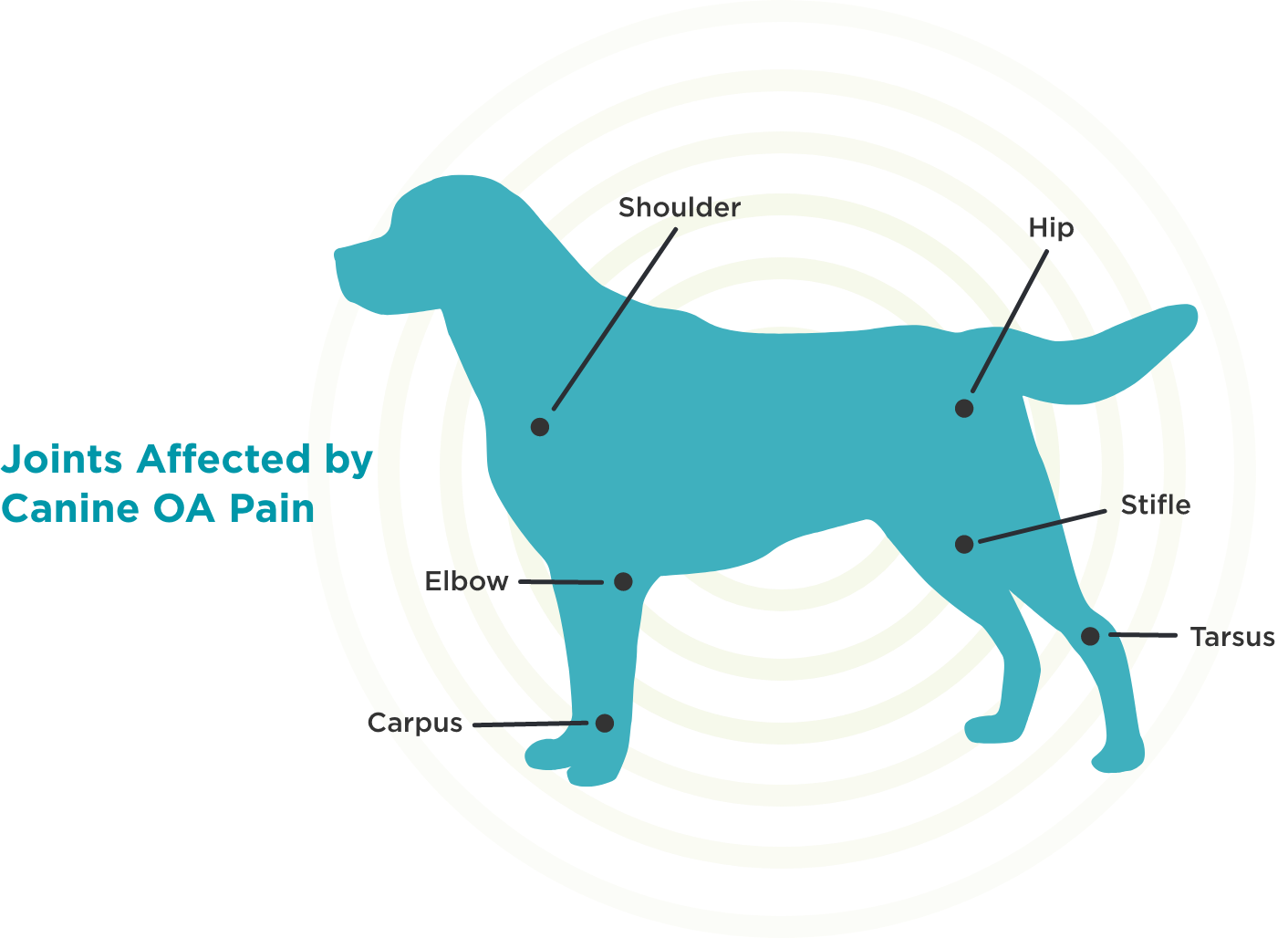

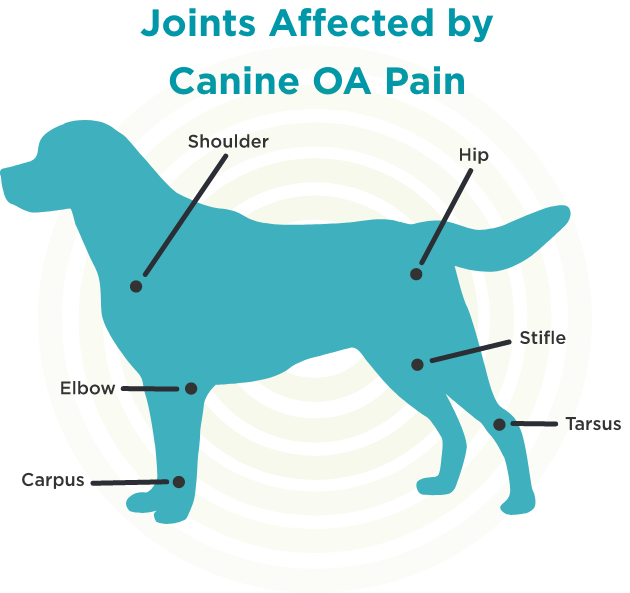
Help Your Clients Recognize the Signs of OA Pain
It’s important for dog owners to monitor the behavior of their dog and look out for the signs of OA pain
Limping after exercise
Lagging behind on walks
Slow to rise
Difficulty jumping
Feeling stiff
Difficulty with stairs
Encourage your clients to take videos of their dog’s daily activities and write down notes about changes in behavior. You can discuss them together at their next appointment.
Encourage your clients to take videos of their dog’s daily activities and write down notes about changes in behavior. You can discuss them together at their next appointment.
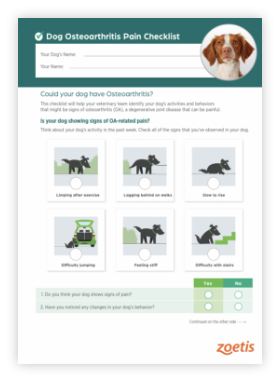


Download this Canine OA Pain Checklist for your practice to help dog owners recognize the signs of canine OA pain.
Download this Canine OA Pain Checklist for your practice to help dog owners recognize the signs of canine OA pain.
TIPS FOR DOG OWNERS
The Journey Back to Play
Insert text here...



Dogs may want to run, jump, play, and increase their activity quickly after treatment with Librela, but it’s important to realize that OA pain could have been affecting their activity levels for a long time.
Insert text here...



As with other pain medications, for dogs that have had their activity restricted due to OA pain, it is recommended that activity should be gradually increased and monitored. A slow increase in activity and exercise over time can help dogs gain back their strength and stamina without the risk of injury.
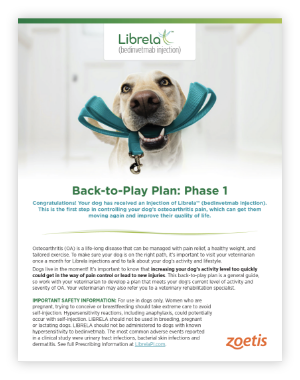


Download a back-to-play treatment sheet to help your clients learn about the phased approach to returning their dog to play during treatment with Librela.
TREATMENT FOR OA PAIN
Treat Dogs Once a Month With Librela
Librela is specifically designed to control canine OA pain with a monthly injection.
Eliminated via normal protein degradation pathways—just like naturally produced antibodies—with minimal metabolism by the liver or kidneys3,4
A monthly subcutaneous injection, administered at the clinic by veterinary professionals
Librela reduced canine OA pain, which led to increased activity and improved quality of life5-8*
*Results from clinical studies conducted in the US and EU.7,8
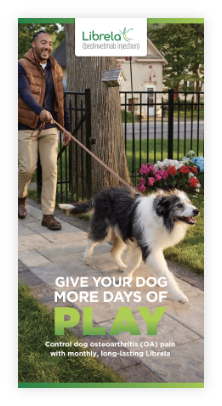


To help your clients learn more about the signs of canine OA and how Librela can help, download the Librela Pet Owner Brochure.
INTERNATIONAL EXPERIENCE
Librela has been commercially available in Europe since 2021, with more than 9 million doses distributed to veterinary professionals9,10†
Librela is rated #1 in Europe for overall product satisfaction by veterinarians who have prescribed it for OA pain11‡
SEE HOW LIBRELA HAS MADE A DIFFERENCE FOR REAL PATIENTS
Results from international experience. Individual results may vary, considering the unique characteristics of the patient.
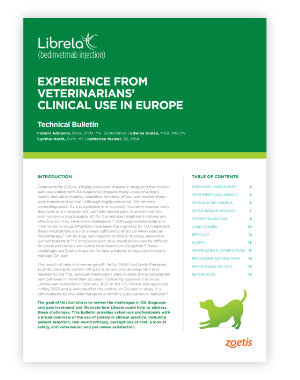


For more information about experience with Librela, download our Technical Bulletin that explains more about clinical use in Europe.
†As of November 2023.
‡According to European surveys with clinical use of Librela.
Insert text here...
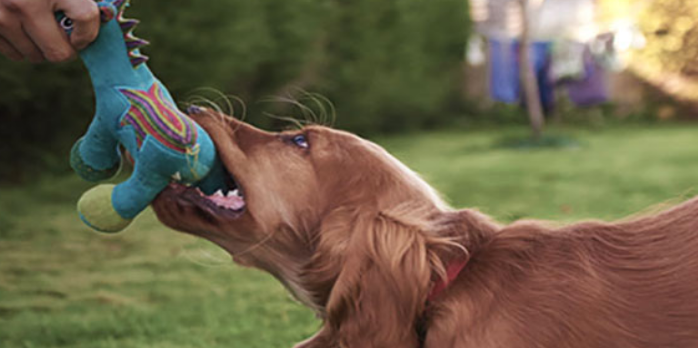
Get a Canine OA Pain Checklist for your clients

View tips about examining dogs for OA

Find out more about the New Science of OA Pain
References:
- Lascelles BDX, Brown DC, Conzemius MG, Gill M, Oshinsky ML, Sharkey M. Measurement of chronic pain in companion animals: discussions from the Pain in Animals Workshop (PAW) 2017. Vet J. 2019;250:71-78. doi:10.1016/j.tvjl.2019.07.001
- Anderson KL, Zulch H, O’Neill DG, Meeson RL, Collins LM. Risk factors for canine osteoarthritis and its predisposing arthropathies: a systematic review. Front Vet Sci. 2020;7:200. doi:10.3389/fvets.2020.00220
- Keizer RJ, Huitema AD, Schellens JH, Beijnen JH. Clinical pharmacokinetics of therapeutic monoclonal antibodies. Clin Pharmacokinet. 2010;49(8):493-507. doi:10.2165/11531280
- Olivry T, Bainbridge G. Advances in veterinary medicine: therapeutic monoclonal antibodies for companion animals. Zoetis. March 2015.
- Brown DC, Boston RC, Coyne JC, Farrar JT. Development and psychometric testing of an instrument designed to measure chronic pain in dogs with osteoarthritis. Am J Vet Res. 2007;68(6):631-637. doi:10.2460/ajvr.68.6.631
- Brown DC, Boston RC, Coyne JC, Farrar JT. Ability of the Canine Brief Pain Inventory to detect response to treatment in dogs with osteoarthritis. J Am Vet Med Assoc. 2008;233(8):1278-1283. doi:10.2460/javma.233.8.1278
- Corral MJ, Moyaert H, Fernandes T, et al. A prospective, randomized, blinded, placebo-controlled multisite clinical study of bedinvetmab, a canine monoclonal antibody targeting nerve growth factor, in dogs with osteoarthritis. Vet Anaesth Analg. 2021;48(6):943-955. doi:10.1016/j.vaa.2021.08.001
- Michels GM, Honsberger NA, Walters RR, Tena JKS, Cleaver DM. A prospective, randomized, double-blind, placebo-controlled multisite, parallel-group field study in dogs with osteoarthritis conducted in the United States of America evaluating bedinvetmab, a canine anti-nerve growth factor monoclonal antibody. Vet Anaesth Analg. 2023;50(5):446-458. doi:10.1016/j.vaa.2023.06.003
- Librela authorization. European Medicines Agency. Updated February 2022. https://www.ema.europa.eu/en/medicines/veterinary/EPAR/librela
- Data on File. Zoetis Inc. November 2023.
- Data on file. Zoetis Market Research Study. Zoetis Inc. July 2022.
All trademarks are the property of Zoetis Services LLC or a related company or a licensor unless otherwise noted.
© 2024 Zoetis Services LLC. All rights reserved. LIB-00011R4
IMPORTANT SAFETY INFORMATION:
See full Prescribing Information. For use in dogs only. Women who are pregnant, trying to conceive or breastfeeding should take extreme care to avoid self-injection. Hypersensitivity reactions, including anaphylaxis, could potentially occur with self-injection. LIBRELA should not be used in breeding, pregnant or lactating dogs. LIBRELA should not be administered to dogs with known hypersensitivity to bedinvetmab. The most common adverse events reported in a clinical study were urinary tract infections, bacterial skin infections and dermatitis.

